|
a map of the Japanese island of Yonaguni-jima and the locations
of nearby anomalous underwater discoveries
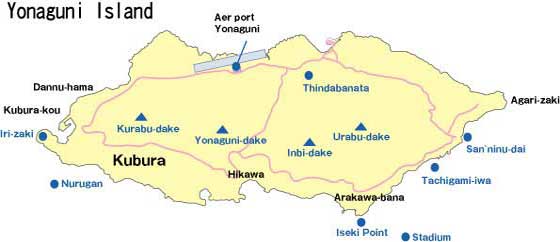
–
Okinawa, Japan
–
One man above all others has made a study of the ‘No.1 monument’ at Iseki Point over the past 10 years, and he is ideally qualified to comment on the discoveries – being a marine geologist. His name is Professor Masaaki Kimura, and in late June 2002 The Morien Institute contacted him at the University of the Ryukyus, Okinawa, Japan. Over the next few months we interviewed Professor Kimura via email, and the following pages contain the questions and answers that passed between us until mid-October 2002. The interview is illustrated with some of Professor Kimura’s photographs and diagrams of the discoveries he made during countless dives over the past 10 years.
These stepped-platforms on the upper terrace of the ‘No 1 monument’ at
Iseki Point have been dismissed by some geologists as being created
by ‘natural forces’, and judged to be simply ‘natural features’.
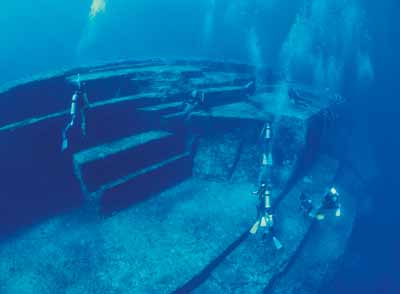
—
Okinawa, Japan
—
Morien Institute:
Professor Kimura, how long have you been studying the underwater structure off the coast of Yonaguni Island at Iseki Point?
Professor Masaaki Kimura:
“I have been studying it during 10 years.”
Morien Institute:
I have read that scuba diving is one of your interests. During the past 10 years, how many dives have you personally made to study the structure at Iseki Point?
Professor Masaaki Kimura:
“More than 100 times.”
the ‘triangle pool’ and part of the ‘loop road’ which runns along the
bottom of the ‘No. 1 monument’ at Iseki Point, Yonaguni
|
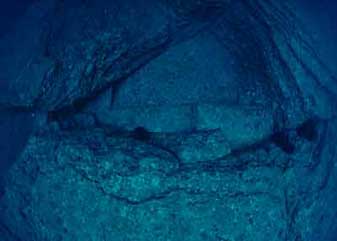
—
Okinawa, Japan
—
|
|
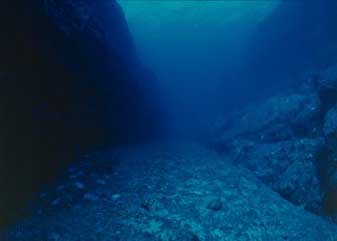
—
Okinawa, Japan
—
|
Morien Institute:
I understand that certain features have been allocated specific names, such as ‘the triangle pool’, ‘the loop road’, and the ‘arch-gate’. Can you explain why these names were assigned to those particular features of the underwater structure at Yonaguni?
Professor Masaaki Kimura:
“Triangle pool: Shape of the depression seems to be a triangle. It resembles a ‘Kaa’ that is an artificial spring for drinking water at Gusuku Castle of ancient Okinawa. The gusuku means a castle including a temple in ancient Okinawa.
Loop road: There is a space looking like a loop road surrounding the No.1 Monument. The widest part is 15 m and the typical part is 6 m wide.
Arch-gate: There are stone fences surrounding the loop road. The entrance to the loop road seems to be an arch-gate the height of which is 1.7 m and the width is 1 m.”
Morien Institute:
What would you describe as the most interesting feature, or features, of the Yonaguni structure, and why?
Professor Masaaki Kimura:
“A rock similar to a face of a man, the height of which is about 7 m. Its eyes are artificial and, a famous free diver, Jacques Mayol liked them very much. Therefore, we call them ‘Jacques eyes’.”
the feature termed the ‘arch-gate’ on the west side of ‘Iseki Point’ at
Yonaguni is shown to the left, and on the right is the image of the
23-foot Moai-like figure showing ‘Jacques Eyes’.
|
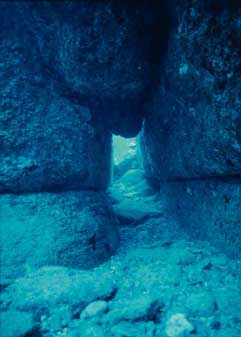
—
Okinawa, Japan
—
|
|
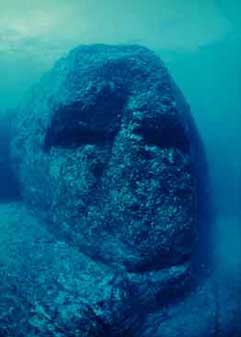
—
Okinawa, Japan
—
|
Morien Institute:
One of the features on the Yonaguni monument is the ‘giant turtle’ that has been carved out of the living rock at the eastern side of the structure. Are there any species of turtle known in the South China Sea area, which have ever been known to grow to this giant size?
Professor Masaaki Kimura:
“I do not know its species. Living turtles may grow about 1.5 m long.”
Morien Institute:
I am told that all Japanese school children are familiar with the Okinawan fable of Urashima Taro, the gentle fisherman, who saved a young turtle from bullies and released it into the ocean, only to be visited by a ‘giant turtle’ who offered him, for his kindness, a ride beneath the sea to a magical kingdom. Could this fable be a folk memory of the ‘giant turtle’ carved onto the Yonaguni monument?
Professor Masaaki Kimura:
“I do not know the direct connection. However, the fable of Urashima (name of a fisherman) is related to this kind of turtle.”
two views of the ‘giant turtle’ on the top of the ‘upper terrace’
on the ‘No. 1 monument’ at Iseki Point, Yonaguni
|
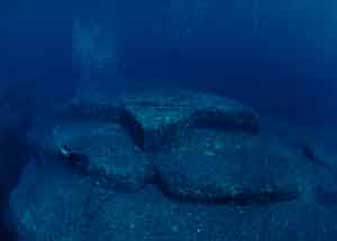
—
Okinawa, Japan
—
|
|
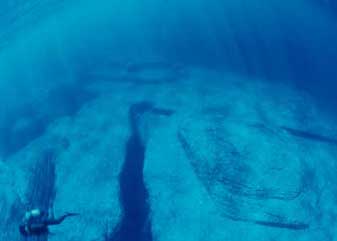
—
Okinawa, Japan
—
|
Morien Institute:
Can you give any details about the stone tools and other artifacts that have been found on the seabed in and around the Island of Yonaguni?
Professor Masaaki Kimura:
“We recovered several pieces of stone tools. Typical ones are adzes. They are not polished. Their age is estimated as up to 10 thousand years old.”
|